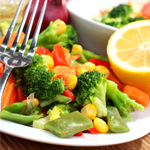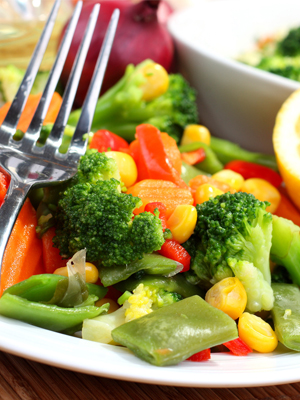Eating a variety of vegetables is the healthiest way to ensure you’re getting enough vitamins. Since the vitamins are coming from a food that has little to no fat and is often low in sodium, you also get to skip over the nutritional tradeoffs that can come from other sources like grains and dairy. All vegetables are good for you, but if you want to get the most bang for your nutritional buck, be choosy about which produce you pick and how you eat it. And now’s the time to start thinking about it: March is Nutrition Month across Canada. Read on for things to consider the next time you’re stocking up on greens.
Remember: Some are mostly water.
Not all veggies are created equal. Of course cucumber and celery are still healthy snacks, but keep in mind that they’re mostly water. In fact, celery actually has a negative caloric intake because you burn more calories chewing it than it contains.
Another water-based offender to keep in mind is iceberg lettuce. It’s no secret that loading up a salad with fattening toppings like creamy dressings, bacon and cheese will counteract the nutrition benefits of the vegetables. But even without those toppings, a salad is much less nutritious when its main ingredient is made up of mostly water. The best leaves to use for a salad are dark greens like spinach or arugula, but if you’re not crazy about the taste, even romaine lettuce has more vitamins than iceberg.
Remember: To eat them as fresh as possible.
The longer vegetables are kept after they’ve been picked, the more nutrients they lose (not to mention their flavour). Vegetables also begin to lose nutrients once they’ve been cut, especially vitamin C. But you don’t have to wait until the last minute to cut your veggies (especially since sometimes having them cut and prepared ahead of time makes them a more appealing snack). By the time any major vitamin loss occurs, they’ll have gone bad anyway.
Try buying them frozen if you keep ending up with spoiled veg. Companies freeze the veggies within a few hours of being picked, so they’ll be fresher than the ones that travelled across the country to your supermarket. To get the most nutrition from your veggies, buy them fresh at farmer’s markets and eat them as soon as possible.
Remember: To eat a variety of colours.
Different coloured vegetables represent different nutrients. Most vegetables are high in fibre and will have a base variety of vitamins. But think of each colour as a specialist for one or two vitamins. Dark, leafy greens like spinach are high in iron, calcium and vitamin K. Orange vegetables like carrots and bell peppers are excellent sources of beta carotene (which gets converted to vitamin A by your body) and vitamin C. Eat as many colours as possible to get a varied vitamin intake “ no one likes eating the same food all the time, anyway.













